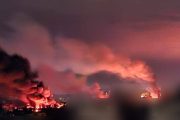
International news reports have shown satellite images of amphibious armored vehicles and mobile missile launchers of the People’s Liberation Army (PLA) massing at military bases in China’s Eastern Theatre Command — in China’s coastal region. These movements place Chinese missiles within range of Taiwan.
The images were originally published by the Canadian military magazine Kanwa Asian Defence. The magazine’s editor, Andrei Chang, wrote of the buildup: “The PLA ground forces want to play an active role in the Taiwan issue because so far their weapon systems are powerful enough to attack Taiwan without the help of missile force.”
“The Taiwan Strait is just 180km [111 miles] across. The PCL191 rocket launchers are able to destroy all military bases and government buildings on the island accurately because the weapons were equipped with the BeiDou navigation satellite system,” Chang added.
A reporter in the South China Morning Post for August 5 cited an unnamed analyst who said the deployment of more amphibious weapons systems in mainland China’s coastal cities across the strait from Taiwan is a sign that the armed forces are intended to play a key role in communist China’s long-standing mission to “reunify Taiwan.”
Mainland Communist China and the Republic of China on Taiwan have been estranged since 1949. During the civil war in China the communist forces of Mao Tse-tung were supplied by the Soviets, while the United States cut off military aid to China’s nationalist leader, Chiang Kai-Shek. President Truman’s special representative to China, George Marshall, boasted that he disarmed 39 anti-communist divisions “with a stroke of the pen.” After this betrayal, Chiang and approximately two million followers escaped to Formosa (now called Taiwan), where they maintained the Republic of China’s (ROC) government, and protected human rights and free enterprise.
The mainland communists never recognized the ROC government or Taiwan’s sovereignty, insisting that the island nation is a Chinese province. Over the years, Taiwan has become increasingly isolated. The UN expelled the ROC in 1971 and admitted Communist China in its place. After the United States established diplomatic relations with the Communist Beijing government 1979, Taiwan-U.S. relations became unofficial and informal. Instead of an ambassador, the United States maintains a de facto embassy in Taipei called the American Institute in Taiwan.
When Secretary of Health and Human Services Alex Azar met with the president of the ROC this week to discuss Taiwan’s successful response to the COVID pandemic, he became the highest ranking U.S. official to visit Taiwan in decades.
It is probably not coincidental that the Chinese chose to send jets across the mid-line of the Taiwan Strait on August 10, while Azar was visiting. The jets were tracked by land-based Taiwanese anti-aircraft missiles and were “driven out” by patrolling Taiwanese aircraft.
Building on the threat posed by the large military buildup along the coast of the mainland, the Chinese evidently decided to engage in a little saber-rattling to show their displeasure with a U.S. Cabinet member lending credibility to the ROC by his presence.
Photo of Chinese missile launcher: Max Smith via wikimedia
Related articles:
China Conducts Naval Exercises and Ballistic Missile Tests in South China Sea
China’s Two New Aircraft Carriers to Take Part in Intimidating War Games
China Conducts Naval Exercises and Ballistic Missile Tests in South China Sea
Tomorrow’s Superpower? China’s Naval Build-up Could Oust U.S. from Pacific
International Tribunal Rules in Favor of Philippines in Dispute With China




